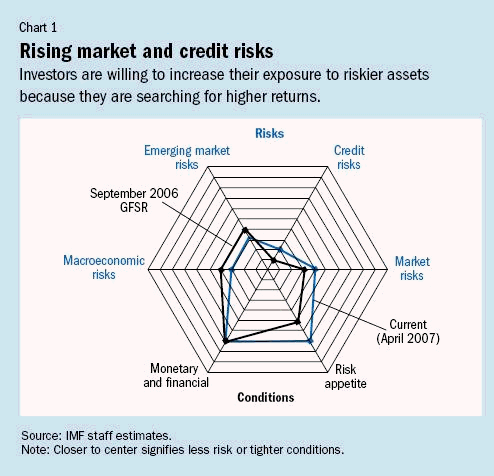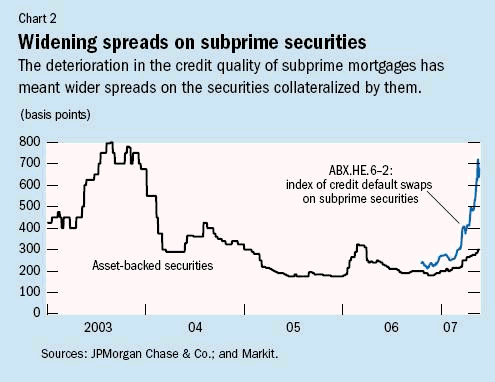
Typical street scene in Santa Ana, El Salvador. (Photo: iStock)
IMF Survey: Financial Conditions Strong but Risks Rising
April 12, 2007
- Financial market volatility across broad asset range remains remarkably low
- Investors may be giving insufficient weight to downside risks
- Competitive pressures, risk models may be helping to perpetuate risk taking
Global economic conditions are underpinning a positive financial environment, but underlying risks and conditions have shifted somewhat since the September 2006 Global Financial Stability Report (GFSR) and have the potential to weaken financial stability.

Foreclosure in Detroit, Michigan, depicts problems of U.S. subprime housing market (photo: Jim West/ZUMA Press)
GLOBAL FINANCIAL STABILITY REPORT
Indeed, despite recent gyrations in world stock markets, financial market volatility across a broad range of assets remains at remarkably low levels and risk spreads remain tight, both historically and relatively to previous business cycles, according to the IMF's April 10 report.
However, investors may be giving insufficient weight to downside risks, perhaps assuming that the current low risk premiums have become a semipermanent feature of the financial landscape. "A market correction, potentially triggered by a `volatility shock,' could be amplified by leveraged positions and uncertainties about concentrations of risk exposures stemming from the rapid growth in innovative, complex products, some of which have rather illiquid secondary markets. For these reasons, we have raised our assessment of market risks," according to the first chapter of the report prepared by the Monetary and Capital Markets Department.

None of the risks by themselves significantly threatens global financial stability. However, investors may not have adequately factored in the possibility that a volatility shock may be amplified, given the increased linkages across products and markets.
The report identified four key areas of heightened short-term risk:
• The U.S. subprime mortgage market: The subprime segment of the U.S. housing market is showing signs of credit quality deterioration; although the fallout has so far been limited and diffused, there is potential for it to deepen and spread to other markets—possibly to structured mortgage credit products held by a variety of global investors (see Box 1).
• Leveraged buyouts: Low interest rates and healthy corporate balance sheets have spurred an increase in private equity buyouts. This has led to a substantial rise in leverage for bought-out firms, potentially making them more vulnerable to economic shocks. "The situation bears careful attention especially if a large high-profile deal runs into difficulty, as this could trigger a wider reappraisal of the risks involved," the report says.
• Capital flows to emerging markets: Capital inflows to some emerging markets have risen rapidly, reflecting in part improved economic fundamentals, but they are also prompted by the search for yield as a result of low real interest rates in most mature markets. In general, strong private capital inflows reflect a reallocation of capital to more productive investments and are to be welcomed. However, the shift to private sector debt flows, especially bank-based flows into emerging Europe and portfolio flows into other regions, including sub-Saharan Africa, shows that foreign investors are taking more risk.
• Global imbalances: Although the downside risk from a possible disorderly unwinding of global payments imbalances has receded, it remains a concern. The larger role fixed-income inflows have played in financing the U.S. current account deficit indicates that inflows may have become more sensitive to changes in world interest rate differentials.
The report sees the growth of carry trades as another sign that market participants do not view the cyclical factors contributing to the low-volatility environment—abundant low-cost liquidity, low leverage in the corporate sector, and high-risk appetite—as likely to reverse in the near term. Investors in the carry trade sell a certain currency with a relatively low interest rate and use the proceeds to purchase a different currency or security yielding a higher rate—which poses risks if either exchange rates or anticipated interest rates change rapidly.
The report argues that competitive pressures and risk models may be helping to perpetuate risk taking. From an individual institution's view, risk taking is a rational response to the current environment but, collectively, could raise systemic risks by causing a buildup of investment positions in certain markets that could result in a disorderly correction were conditions to change.

Rising credit risks
Overall, corporate profits appear robust, balance sheets are strong, credit spreads have declined further, and default rates remain low. However, corporate debt in private markets is rising from low levels as a result of the boom in leveraged buyout activity.
Risks from the U.S. subprime mortgage market
Although there are some signs that the U.S housing market is stabilizing, risks of further deterioration cannot be ruled out, the report states. Overall, the U.S. mortgage market has remained resilient, but the subprime segment has deteriorated more rapidly than had been expected at this point in a housing downturn. The fallout has so far been limited to subprime originators and lenders, but could still affect other market participants.
U.S. residential mortgage-related securities represent one of the largest pools of fixed-income securities in the world, totaling about $5.8 trillion as of January 2007. Non-U.S. holdings of these securities, estimated at $850 billion as of mid-2006, represent a significant portion of foreign holdings of U.S. securities.
The report argues that although credit risk is concentrated among subprime borrowers—those with impaired or limited credit histories—there is a risk that other, higher-quality mortgage collateral may be subject to some of the underwriting weaknesses observed in the subprime sector. That would hurt profitability at banks that invest in, originate, securitize, and structure mortgages; other credit markets that were fueled by rising house prices may also be at risk. The report cites anecdotal evidence suggesting that overseas investors and hedge funds also have significant exposure to the riskier portions of the collateralized debt obligation market exposed to subprime risks.
The size of target companies in the current wave of leveraged buyouts (LBOs) is much larger than those in the 1980s and late 1990s, and the use of loans is expanding more than that of high-yield bonds. So far, target firms are mostly those with strong cash flows and low debt.
But some LBO-acquired firms have become heavily indebted and may thus be more fragile if there is an economic downturn. At the same time, there appears to be less due diligence and a general weakening of loan covenants in more recent deals. In view of these developments and those in the U.S. housing market, the IMF's overall assessment is that credit risks have increased since last September, although from a low level.
Bigger risk appetite
Emerging market countries generally continue to follow sound macroeconomic polices, external positions remain generally strong, and robust growth has improved fiscal positions in many countries, the report says. Despite recent declines, commodity prices remain high. Where sovereign issuance in international capital markets has declined, private corporate issuance has filled the void.
The favorable external environment and accompanying rise in risk appetite—reflected in the rapid rise in capital flows to some emerging market countries—pose challenges for those authorities and could threaten financial and economic stability, especially if capital flow were reversed. In some countries, the generally strong external position of the government may mask potentially growing vulnerabilities for corporations and banks. The report urges policymakers to manage stability risks by making sure that investors adequately understand and appreciate the risks they are taking.







